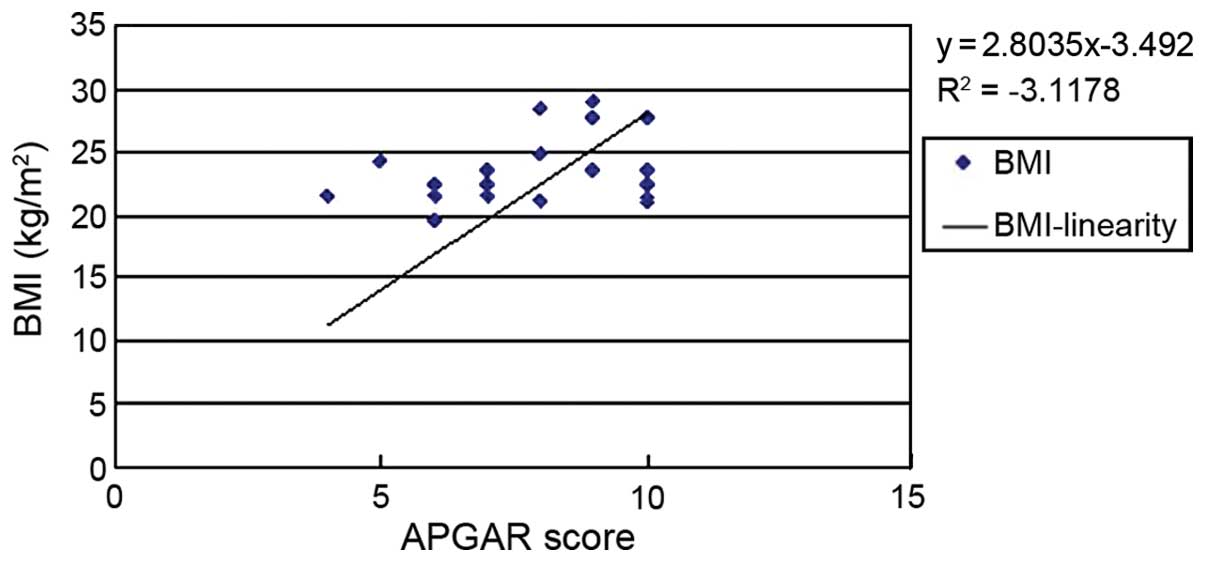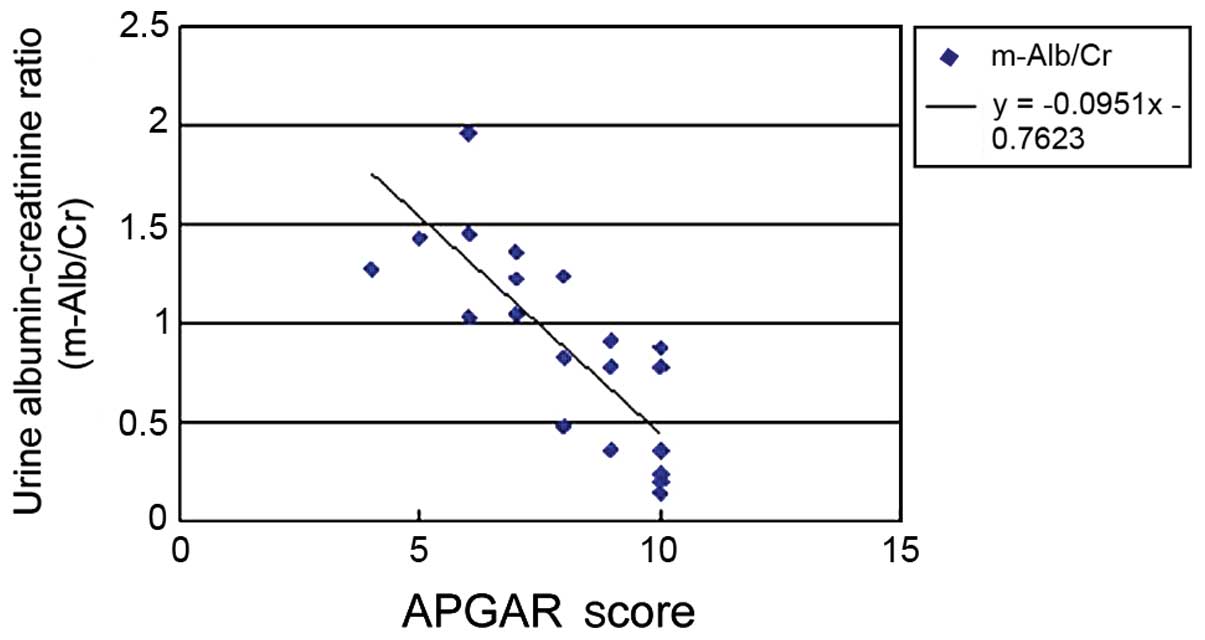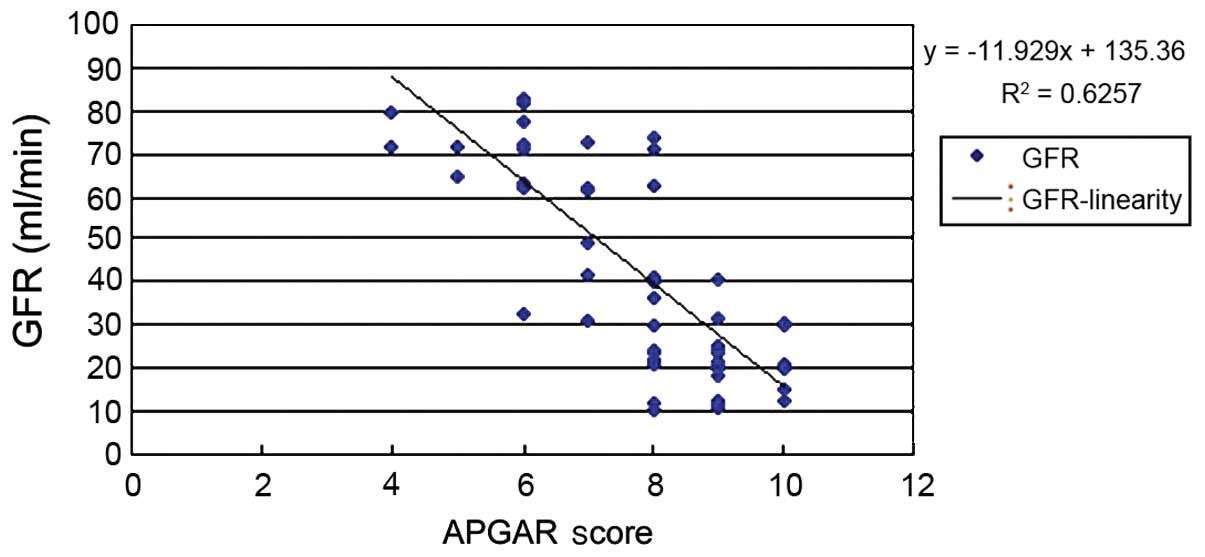Influence of random urine albumin-creatinine ratio of pregnant women with hypertension during the gestation period on perinatal outcome
- Authors:
- Published online on: August 25, 2016 https://doi.org/10.3892/etm.2016.3620
- Pages: 2521-2526
-
Copyright: © Yan et al. This is an open access article distributed under the terms of Creative Commons Attribution License.
Abstract
Introduction
The kidney undergoes a number of changes in internal structure and function during pregnancy. During normal pregnancy, the placenta and mother produce large amounts of hormones including human chorionic gonadotropin (HCG), human placental lactogen (h-PL), steroid hormones and estrogen (1). Such changes in hormone levels can lead to changes in angiotasis and increase water-sodium retention and the volume load, resulting in changes of maternal hemodynamics and kidney structure and function (2–6). During normal pregnancy, 24-h urine protein and urinary albumin excretion increase significantly after 20 weeks to 200–300 mg and 12–19 mg, respectively. The maximum urinary protein content can reach 500 mg/24 h (7,8).
The random urine albumin-creatinine ratio (ACR) is a reliable method for determining the urine protein-creatinine ratio and monitoring urinary protein excretion. The determination of the urine protein-creatinine ratio can effectively reflect the 24-h urine protein content of pregnant women. It is fast, simple, accurate and has other positive aspects that make it an ideal clinical indicator for the qualitative and quantitative diagnosis of proteinuria and for follow-up. It can replace the traditional 24-h urine protein excretion quantification method (5). Clinically, proteinuria is often determined with 24-h urine protein, and normal urinary protein content is generally less than 0.15 g/24 h. However, this method is associated with difficulties such as being greatly influenced by maternal compliance. This is because of the longer urine sample collection time, especially when colleting 24-h urine sample from patients with young children. Therefore, the urine protein-creatinine ratio can be determined immediately to predict the 24 h urine protein content (9).
In the present study, random urine ACR was incorporated into evaluation and the perinatal outcomes of women were tracked and observed. Various risk factors affecting gestational hypertension and proteinuria were comprehensively analyzed to identify the risk factors of proteinuria of pregnant women with hypertension.
Patients and methods
Inclusion and exclusion criteria
The inclusion criteria of the study were: i) Women of childbearing age, >18; and ii) those with proteinuria during pregnancy. The exclusion criteria for the study were: i) Diabetes before pregnancy and previous history of hypertension; ii) pregnant women with lung infection, urinary system infection or other infections, cancers of the reproductive system or breast cancer; iii) heart, liver, kidney, lung and other organ failure; iv) dying from any diseases; v) abnormal blood clotting mechanism; vi) pregnant women or their families who could not provide cooperation; vii) history of mental illness; viii) not reaching the expected date of confinement or those whose families required terminating the pregnancy.
Clinical data
A total of 6,758 pregnant women with pregnancy-induced hypertension and proteinuria were randomly selected in the Yantai region from September, 2009 to June, 2011. The average age of participants was 25.3±12.6 years, with mean arterial pressure of 118.5±21.3 mmHg and 24-h urine protein content of 121.7±14.5 mg.
Data collection
An experienced gynecologist collected the detailed medical history, conducted the physical examination on the participants and recorded their age, gender, height, weight, body mass index (BMI), blood triglyceride, blood low-density lipoprotein cholesterol, blood high-density lipoprotein cholesterol, serum insulin, fasting blood glucose, glycated hemoglobin, aspartate transaminase, γ-glutamyl transpeptidase, creatinine, history of hypertension and history of diabetes.
Diagnostic criteria
The diagnostic criteria were as follows (5): According to the 1999 WHO diagnostic criteria, ≥2 measurements were carried out where systolic blood pressure >140 mmHg or diastolic blood pressure >90 mmHg, or antihypertensive medications were being taken.
According to the 1999 WHO-IDF standards published, ≥2 random measurements were carried out where blood glucose >11.1 mmol/l or fasting glucose >7.0 mmol/l, there was definitive history of diabetes, or hypoglycemic agents were being taken.
Urine ACR ratio was reliably correlated with 24-h urine protein and the reference value was generally in the range of 0.10–0.20.
First morning urine was completely drained and urine was collected from the second urination. The first urine time was recorded and used as reference for 24 h on the following day. All urine within 24 h was placed in a container and mixed evenly, then 100–200 ml was extracted. The protein content in the healthy urine was generally 40–80 mg. Beyond this range, the diagnosis of proteinuria was made.
Glomerular filtration rate (GFR): The amount of filtered liquid generated from the two kidneys of normal adults was 80–120 ml/min.
Other biochemical indicators were tested with the assistance of the clinical laboratory of Yantaishan Hospital (Shandong, China).
The APGAR score (8) included skin color, heart rate, reaction of flicking planta pedis or inserting nasal tube, muscle tension and breathing of the delivered newborn (Table I).
Statistical analysis
Data were presented as mean ± standard error. The Pearson correlation analysis was performed to investigate associations between various indicators. In addition, multivariate and logistic regression analyses were carried out to identify the variables predictive of APGAR scores. P<0.05 was consideted to indicate a statistically significant difference.
Results
General clinical parameters of the enrolled participants
A total of 6,758 pregnant women with combined gestational hypertension and proteinuria diagnosed at the Department of Obstetrics and Gynecology in Yantaishan Hospital from September, 2009 to June, 2011 were randomly selected for the study. Kidney function, blood pressure, history of gravidity and parity, embryo number and birth weight of the enrolled participants were determined. The average age of participants was 25.3±12.6 years, with mean arterial pressure of 118.5±21.3 mmHg and 24-h urine protein content of 121.7±14.5 mg. According to the medical examination information of pregnant women, various indicators were recorded before and after pregnancy and statistical analysis was performed (Table II).
Pearson correlation analysis between perinatal outcomes and other factors
We recorded and statistically analyzed the APGAR scores of newborns delivered by the participants. According to a literature review, the indicators affecting APGAR score during pregnancy were screened as independent variables and a correlation analysis was performed. The results showed that BMI (Fig. 1), urinary ACR (Fig. 2) and GFR (Fig. 3) of pregnant women were related to the APGAR score and the differences were statistically significant (P<0.05; Table III).
Table III.Correlation analysis between the APGAR score and the detection indicators of pregnant women. |
Multivariate and logistic regression analysis on perinatal outcomes and other factors
A logistic regression analysis on all risk factors was performed, and we found that urine ACR and the APGAR score were positively correlated and the correlation coefficient was −0.0951. The difference was statistically significant (P=0.001; Table IV).
Discussion
Proteinuria during pregnancy severely affects the health of the fetus and mother (2). In normal delivery or after termination of pregnancy, these changes may gradually be restored. Under the physiological environment of pregnancy, previous kidney diseases may become worse and severe cases may cause new kidney damage such as acute renal failure (5,7,9–11). From the classification of pregnancy-related kidney diseases, kidney diseases caused by pregnancy do not include pre-eclampsia and eclampsia-induced renal lesions, or diseases occurring before pregnancy such as preeclampsia-associated focal segmental glomerulosclerosis. Some kidney diseases before pregnancy such as focal segmental glomerulosclerosis, IgA nephropathy, membranous nephropathy, reflux nephropathy and even lupus nephritis may be triggered by pregnancy. In addition, hemolytic uremic syndrome and renal cortical necrosis after pregnancy is not uncommon (12–16). In the present study, the average age of enrolled women was 25.3±12.6 years, with mean arterial pressure of 118.5±21.3 mmHg and 24 h urine protein content of 121.7±14.5 mg. None of the pregnant women had significant hypertension or proteinuria prior to pregnancy.
We determined the indicators associated with proteinuria during pregnancy from the relevant literature and statistically analyzed them in the study participants. The results showed that the BMI, urine ACR and GFR of pregnant woman were associated with the APGAR score and the differences were statistically significant (P<0.05). The Pearson correlation analysis diagram for BMI and APGAR score was y=2.8035x-3.492, but in multivariate analysis (P>0.05). During pregnancy, change in weight is highly related to gestational week and fetal weight, although we found there was a linear relationship between weight and the APGAR score. However, there were many confounding factors in the linear relationship, and after the exclusion of these factors, no significant correlation between BMI and APGAR score was found (P>0.05).
We also analyzed the relationship between GFR and the APGAR score and found that y=−11.929x+135.36 (P>0.05). According to previous literature, an increase in GFR mainly occured because of increased space between glomerular podocytes, caused by renal lesions. Among women with hypertensive proteinuria, the hypertension-induced glomerular perfusion pressure was significantly increased because membrane filtration permeability was increased. In addition, HCG, h-PL, steroid hormones and estrogen during pregnancy may have increased GFR. Decreased negatively charged salivary proteins on the filtration membrane attenuated the repulsion effect on albumin which was also negatively charged, and proteinuria occurred. However, it was not considered the influencing factor on perinatal outcome.
The determination of urine protein-creatinine ratio can effectively reflect the maternal 24-h urine protein content and excludes the result bias caused by poor compliance and many other factors. In the present study, we found a linear relationship between maternal ACR and APGAR score, y=−0.0951x-0.7623 (P<0.05), suggesting that proteinuria may affect the fetus in utero, thereby affecting perinatal outcomes. Previous studies showed that if early proteinuria during pregnancy was >300 mg/24 h, careful clinical attention should be given. These patients were frequently combined with gestational hypertension, leading to reduced fetal survival rate, growth retardation and premature birth (13,15,16–18). Proteinuria during pregnancy can manifest as mild proteinuria, combined proteinuria and hypertension, severe pre-eclampsia, severe eclampsia and other serious obstetric complications that potentially cause hypoxia, acidosis, bleeding, microcirculation, multiple organ failure and other serious complications (19–22).
In summary, there is an important correlation between perinatal maternal ACR and perinatal outcome. The increase in random urine ACR may predict postpartum outcome. Intervention in early pregnancy or before pregnancy has important clinical significance in reducing adverse complications for infants and mothers such as hypertension in pregnancy and improving the outcome of pregnancy.
References
|
Puri CP and Garfield RE: Changes in hormone levels and gap junctions in the rat uterus during pregnancy and parturition. Biol Reprod. 27:967–975. 1982. View Article : Google Scholar : PubMed/NCBI | |
|
Duvekot JJ, Cheriex EC, Pieters FA, Menheere PP and Peeters LH: Early pregnancy changes in hemodynamics and volume homeostasis are consecutive adjustments triggered by a primary fall in systemic vascular tone. Am J Obstet Gynecol. 169:1382–1392. 1993. View Article : Google Scholar : PubMed/NCBI | |
|
Holobotovskyy V, Chong YS, Burchell J, He B, Phillips M, Leader L, Murphy TV, Sandow SL, McKitrick DJ, Charles AK, et al: Regulator of G protein signaling 5 is a determinant of gestational hypertension and preeclampsia. Sci Transl Med. 7:290ra882015. View Article : Google Scholar : PubMed/NCBI | |
|
Yi WY and Lin XJ: Clinical analysis of 43 cases of nephrotic syndrome with pregnancy induced hypertension. Chin Birth Health Hered. 6:76–78. 2007.(In Chinese). | |
|
Fraser A, Nelson SM, Macdonald-Wallis C, Sattar N and Lawlor DA: Hypertensive disorders of pregnancy and cardiometabolic health in adolescent offspring. Hypertension. 62:614–620. 2013. View Article : Google Scholar : PubMed/NCBI | |
|
Thoulass JC, Robertson L, Denadai L, Black C, Crilly M, Iversen L, Scott NW and Hannaford PC: Hypertensive disorders of pregnancy and adult offspring cardiometabolic outcomes: A systematic review of the literature and meta-analysis. J Epidemiol Community Health. 70:414–422. 2016. View Article : Google Scholar : PubMed/NCBI | |
|
Chen TK, Gelber AC, Witter FR, Petri M and Fine DM: Renal biopsy in the management of lupus nephritis during pregnancy. Lupus. 24:147–154. 2015. View Article : Google Scholar : PubMed/NCBI | |
|
McCarthy EA, Carins TA, Hannigan Y, Bardien N, Shub A and Walker SP: Effectiveness and safety of 1 vs 4 h blood pressure profile with clinical and laboratory assessment for the exclusion of gestational hypertension and pre-eclampsia: A retrospective study in a university affiliated maternity hospital. BMJ Open. 5:e0094922015. View Article : Google Scholar : PubMed/NCBI | |
|
Pahwa MB, Seth S and Khosla A: Significance of urine protein/creatinine ratio in pregnancy-induced hypertension. Clin Chimacta. 382:145–147. 2007. View Article : Google Scholar | |
|
Van Lente F and Suit P: Assessment of renal function by serum creatinine and creatinine clearance: Glomerular filtration rate estimated by four procedures. Clin Chem. 35:2326–2330. 1989.PubMed/NCBI | |
|
Milnerowicz-Nabzdyk E, Zimmer M, Tlolka J, Michniewicz J, Pomorski M and Wiatrowski A: Umbilical cord morphology in pregnancies complicated by IUGR in cases of tobacco smoking and pregnancy-induced hypertension. Neuro Endocrinol Lett. 31:842–847. 2010.PubMed/NCBI | |
|
Dong XD and Peng J: Pregnancy combined with chronic glomerulonephritis. Chin Obstetric Emergency. 2:96–98. 2012.(In Chinese). | |
|
Zhou JF, Wang XY, Shangguan XJ, Gao ZM, Zhang SM, Xiao WQ and Chen CG: Increased oxidative stress in women with pregnancy-induced hypertension. Biomed Environ Sci. 18:419–426. 2005.PubMed/NCBI | |
|
Egerman RS, Witlin AG, Friedman SA and Sibai BM: Thrombotic thrombocytopenic purpura and hemolytic uremic syndrome in pregnancy: Review of 11 cases. Am J Obstet Gynecol. 175:950–956. 1996. View Article : Google Scholar : PubMed/NCBI | |
|
Li YQ, Wu YY, Gong X, Wu XF, Liu HY and Qiao FY: The study about the relationship between the kidney injury in gestational hypertension and the pregnancy outcomes. Chin Birth Health Hered. 3:71–72. 2013.(In Chinese). | |
|
Morikawa M, Yamada T, Yamada T, Shimada S, Koyama T, Cho K and Minakami H: Pregnancy-induced antithrombin deficiency. J Perinat Med. 38:379–385. 2010. View Article : Google Scholar : PubMed/NCBI | |
|
Sugisaki T: Mechanism by which proteinuria exacerbates kidney diseases. Nippon Naika Gakkai Zasshi. 90:1292–1298. 2001.(In Japanese). View Article : Google Scholar : PubMed/NCBI | |
|
Thornton CE, Makris A, Ogle RF, Tooher JM and Hennessy A: Role of proteinuria in defining pre-eclampsia: Clinical outcomes for women and babies. Clin Exp Pharmacol Physiol. 37:466–470. 2010. View Article : Google Scholar : PubMed/NCBI | |
|
Bramham K, Briley AL, Seed P, Poston L, Shennan AH and Chappell LC: Adverse maternal and perinatal outcomes in women with previous preeclampsia: A prospective study. Am J Obstet Gynecol. 204:512.e1–512.e9. 2011. View Article : Google Scholar | |
|
Craici IM, Wagner SJ, Weissgerber TL, Grande JP and Garovic VD: Advances in the pathophysiology of pre-eclampsia and related podocyte injury. Kidney Int. 86:275–285. 2014. View Article : Google Scholar : PubMed/NCBI | |
|
Ahmed A and Ramma W: Unravelling the theories of pre-eclampsia: Are the protective pathways the new paradigm? Br J Pharmacol. 172:1574–1586. 2015. View Article : Google Scholar : PubMed/NCBI | |
|
Law KP, Han TL, Tong C and Baker PN: Mass spectrometry-based proteomics for pre-eclampsia and preterm birth. Int J Mol Sci. 16:10952–10985. 2015. View Article : Google Scholar : PubMed/NCBI |












